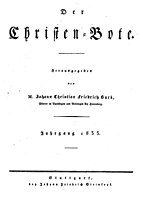Johann Friedrich Steinkopf
Johann Friedrich Steinkopf (born May 17, 1771 in Ludwigsburg , † April 4, 1852 in Stuttgart) was a German bookseller, publisher and antiquarian.
Life
Johann Friedrich Steinkopf was born on May 17, 1771 in Ludwigsburg as the oldest of 14 children. His father was the drawing teacher at the illustrious grammar school in Stuttgart, court painter and porcelain painter Johann Friedrich Steinkopf (1737-1825). His mother was Katharina Barbara Betulius (1754–1816), a daughter of the master bookbinder, antiquarian and publisher Johann Christoph Betulius (1728–1791). His siblings included pastor Carl Friedrich Adolf Steinkopf (1773–1859), painter Gottlob Friedrich Steinkopf (1779–1861) and antiquarian Ferdinand Steinkopf (1787–1828).
Betulius owned a house at Holzstrasse 16 in Stuttgart. Steinkopf lived in the grandfather's house from the age of two. From 1785 Steinkopf worked occasionally, from 1791 constantly in his grandfather's company. After his death in 1791 Steinkopf took over the company in 1792, which he continued as " JF Steinkopf Verlag ". In 1806 he acquired the printing house from Karl Jakob Klett. In 1815 he transferred the bookshop to his brother Ferdinand Steinkopf. After his death, he reintegrated the antiquarian bookshop into his publishing house under the management of his nephew Gustav Süskind (1809–1895). In 1844 he sold the bookshop to his nephew. Steinkopf transferred the bookstore and printing works to his nephew Rudely Karl Louis Hänel (1808–1847), who had been a partner since 1834. After his early death in 1847, Friedrich August Steinkopf (1824–1903), a son of Ferdinand Steinkopf, took over the publishing house.
Publishing program
A focal point in the program of the Steinkopf Verlag were works by pietistic authors such as Johann Albrecht Bengel , Sixt Karl Kapff , Philipp Friedrich Hiller and Ludwig Hofacker , including the “Daily Handbook in Good and Bad Days” by Johann Friedrich Starck , the one and a half For centuries it was printed in ever new editions.
The “Economic Handbook for Women”, published in 1792, developed with Volume 1, a cookbook by Friederike Luise Löffler, into a bestseller that is still reprinted to this day.
From 1831 Christian Friedrich Burk published the Sunday paper “Der Christenbote” at Steinkopf, which appeared until the Nazis banned it in 1941. From 1836 the Pietist pastor Christian Gottlob Barth published the magazine “Jugendblätter” at Steinkopf.
family
In 1799 Steinkopf married Dorothea Morstatt, who died in 1800 after the birth of her son Friedrich (1800–1821). The son died in 1821 at the age of 21. In 1801 Steinkopf married Julie Magdalene Wallot (1778-1857) for the second time, and she lost her only child at an early age. Steinkopf died after eight days of illness at the age of almost 81 on April 4, 1852 in Stuttgart, his wife survived him by 5 years. Both are buried in a common grave on the Hoppenlaufriedhof in Stuttgart.
Honors
- 1842: Order of the Württemberg crown (on the 50th anniversary of the business).
literature
- Waltraud Pfäfflin; Friedrich Pfäfflin: The graves of the poets on the Stuttgart Hoppenlau cemetery. With an essay by Udo Dickenberger. Stuttgart: Edition Vincent Klink, 2015, pages 91–93, 364–365.
- Rudolf Schmidt: German bookseller. German book printer. Contributions to a company history of the German book industry. Volume 5. Berlin: Verlag der Buchdruckerei Franz Weber, 1908, pages 930-934, online .
- Studbook Karl Friedrich Adolf Steinkopf. 1795-1801, online .
- From the Steinkopf family chronicle. A commemorative sheet for August 1, 1898. Stuttgart: JF Steinkopf, 1898.
Web links
Footnotes
- ↑ #Schmidt 1908 , #Steinkopf 1898 , # Pfäfflin 2015 , pp. 91–93.
- ↑ # Pfäfflin 2015 , pp. 91–92.
- ↑ #Steinkopf 1898 , page 9.
| personal data | |
|---|---|
| SURNAME | Steinkopf, Johann Friedrich |
| BRIEF DESCRIPTION | German bookseller, publisher and antiquarian |
| DATE OF BIRTH | May 17, 1771 |
| PLACE OF BIRTH | Ludwigsburg |
| DATE OF DEATH | April 4, 1852 |
| Place of death | Stuttgart |


